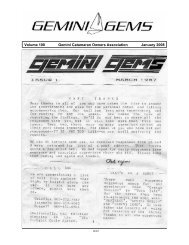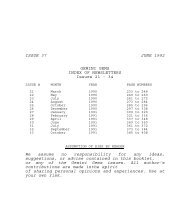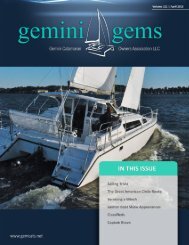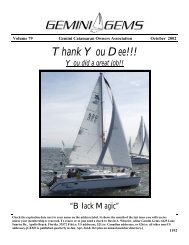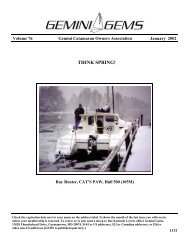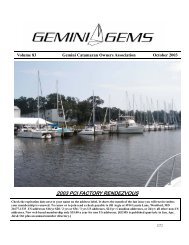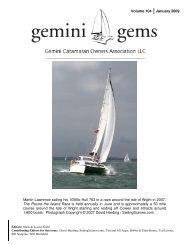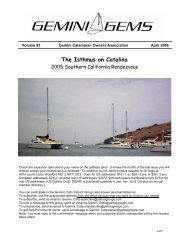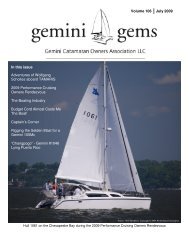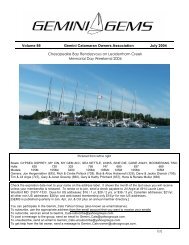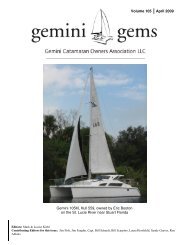Gemini Owners Manual.pub - Gemini Gems
Gemini Owners Manual.pub - Gemini Gems
Gemini Owners Manual.pub - Gemini Gems
You also want an ePaper? Increase the reach of your titles
YUMPU automatically turns print PDFs into web optimized ePapers that Google loves.
<strong>Gemini</strong> 105Mc Owner’s <strong>Manual</strong><br />
Design Considerations<br />
window slider.<br />
Construction<br />
In comparison to any other cruising sailboat with<br />
the same accommodation, the <strong>Gemini</strong> is faster,<br />
lighter, has less sail area, draws less water, and<br />
sails more upright. Performance Cruising has built<br />
more than 800 <strong>Gemini</strong>’s and is constantly refining<br />
the product and manufacturing techniques. As<br />
such, Performance Cruising builds a 34' catamaran<br />
more cost effectively than any other sailboat factory<br />
can build a sailboat of similar accommodation.<br />
The conventional monohull has a fixed keel, fixed<br />
rudders, and fixed inboard diesel. This simplicity<br />
makes the boat easier to build and less expensive.<br />
The cheap cast iron keel is the low cost solution to<br />
turning an unstable single hull into a sailboat with a<br />
mast and sails that are trying to tip it over. The<br />
draw back to this keel is deep draft and weight. A<br />
heavy boat needs more sail and a larger engine.<br />
Most people think the keel is a weight hanging under<br />
the boat trying to pull it upright. Unfortunately,<br />
with the keel weighing, say 5,000 lbs., and the<br />
loaded hull weighing 11,000 lb., the point at which<br />
all this weight can be assumed to act to bring the<br />
boat upright (the center of gravity), is near the<br />
water line and not several feet under the boat. This<br />
makes for a boat that will tip easily and is very uncomfortable.<br />
The modern fast monohull has a very deep keel<br />
with a bulb, a high-tech light hull, and wide beam.<br />
Interior Molds<br />
The <strong>Gemini</strong> 105Mc advanced construction includes a<br />
single interior mold encompassing the area from<br />
stem to stern and port to starboard. This interior<br />
mold is unique to the entire multihull industry and<br />
provides a multitude of benefits including enormous<br />
weight savings as well as incredible strength. The<br />
interior mold is built with a wiring harness which<br />
includes 110 volt wires, hoses, and conduit for electronics<br />
glassed in before it is structurally glassed in<br />
to the hull. There are also several small accent<br />
molds.<br />
The roof mold is rather light and has 12 volt wire<br />
glassed into position before it is glassed to the<br />
deck. This mold has cutouts to facilitate bolting on<br />
genoa tracks, winches and cabin lights. This mold<br />
also has a glassed in flange to take the main bulkhead.<br />
The refrigerator mold is 7' wide and high and covers<br />
the main cockpit bulkhead. This mold has a box<br />
to enclose the refrigerator and another box for storage<br />
or an air conditioner. This mold is glassed into<br />
position and ensures that the refrigerator vents to<br />
the outside. This mold also has the grooves for the<br />
Sails and Sailing<br />
Copyright © 2004 Performance Cruising Inc.<br />
The aft cabin walls are large molds that stand vertical<br />
to separate the aft cabin. They are bolted into<br />
place after the hull and deck have been bonded.<br />
Buoyancy Tanks<br />
The <strong>Gemini</strong> has (4) four buoyancy tanks situated in<br />
each corner of the boat. These buoyancy tanks are<br />
not designed to float the whole boat but to stop a<br />
holed hull from going down too far and allowing<br />
water to flood across to the other hull and capsize<br />
the boat.<br />
These buoyancy tanks are air filled tanks, but are<br />
not guaranteed as fully airtight. They should be inspected<br />
periodically to make sure they are dry.<br />
Each tank has an opening inspection port. In the<br />
head, the port is located directly behind the toilet<br />
plumbing. In the aft cabins, the port is located on<br />
the aft cabin stern wall. In the master cabin, the<br />
port is located under the carpeting in the large forward<br />
storage locker.<br />
For offshore use, it is advisable to fill the tanks<br />
with either airtight plastic bottles or Styrofoam<br />
chips contained in netting (to make removal easier).<br />
The inside of the tank should be accessible to test<br />
for leaks. As such, it is not advisable to fill the<br />
tanks with permanent foam or any material that<br />
cannot be easily removed.<br />
Leaks<br />
If a leak is detected, first taste the water to see if it<br />
is salty. If it is fresh, the leak is either water from<br />
the water tanks or a topside leak from rain. If it is<br />
salty then it is a hull leak.<br />
The best way to find a hull leak is to completely dry<br />
the bilge and look for telltale trickles of water. It<br />
may be necessary to dry the bilge repeatedly because<br />
the first telltale trickle could be from water<br />
trapped behind a bulkhead. The leaks are almost<br />
certainly from a through-hull fitting, so be sure to<br />
check<br />
• Speedo<br />
• Depth sounder<br />
• Toilet through hulls<br />
• Centerboard pivot<br />
• Engine water inlet<br />
• Air Conditioning inlet<br />
A boat in rough seas could have a leak from up high<br />
such, as the gunwale joint, sail locker, anchor<br />
locker, or deck fittings.<br />
32



